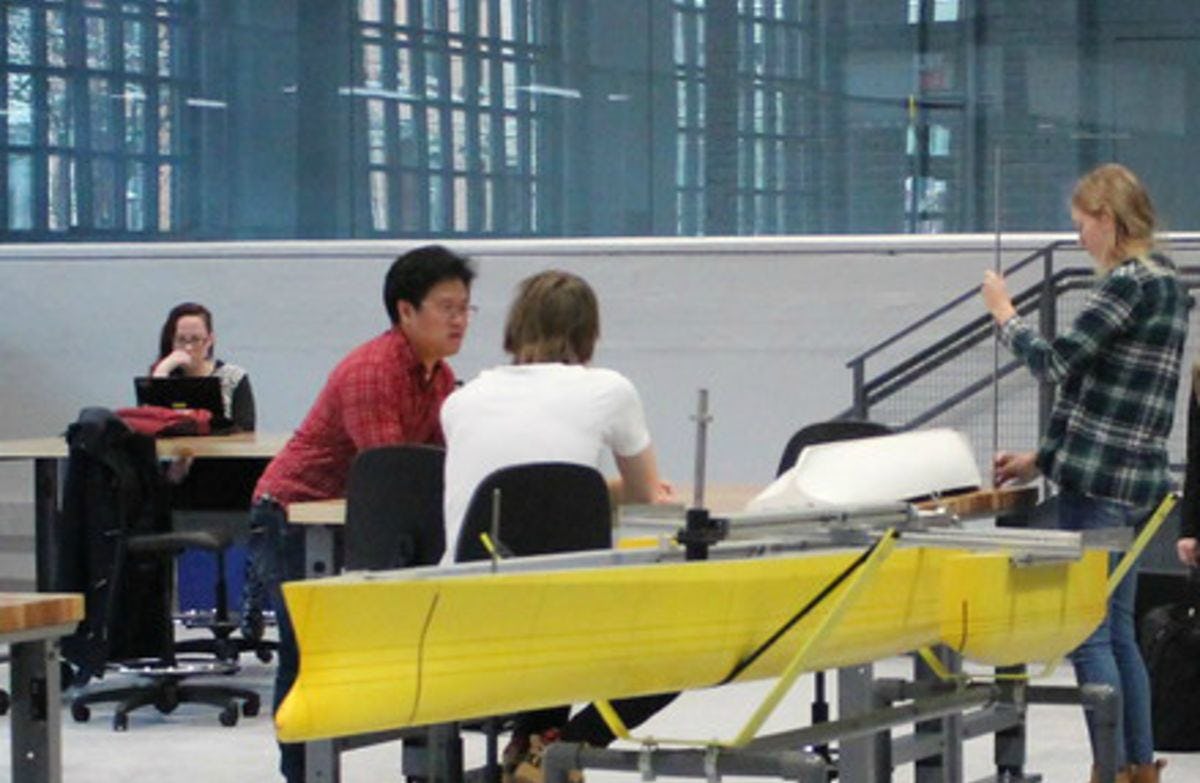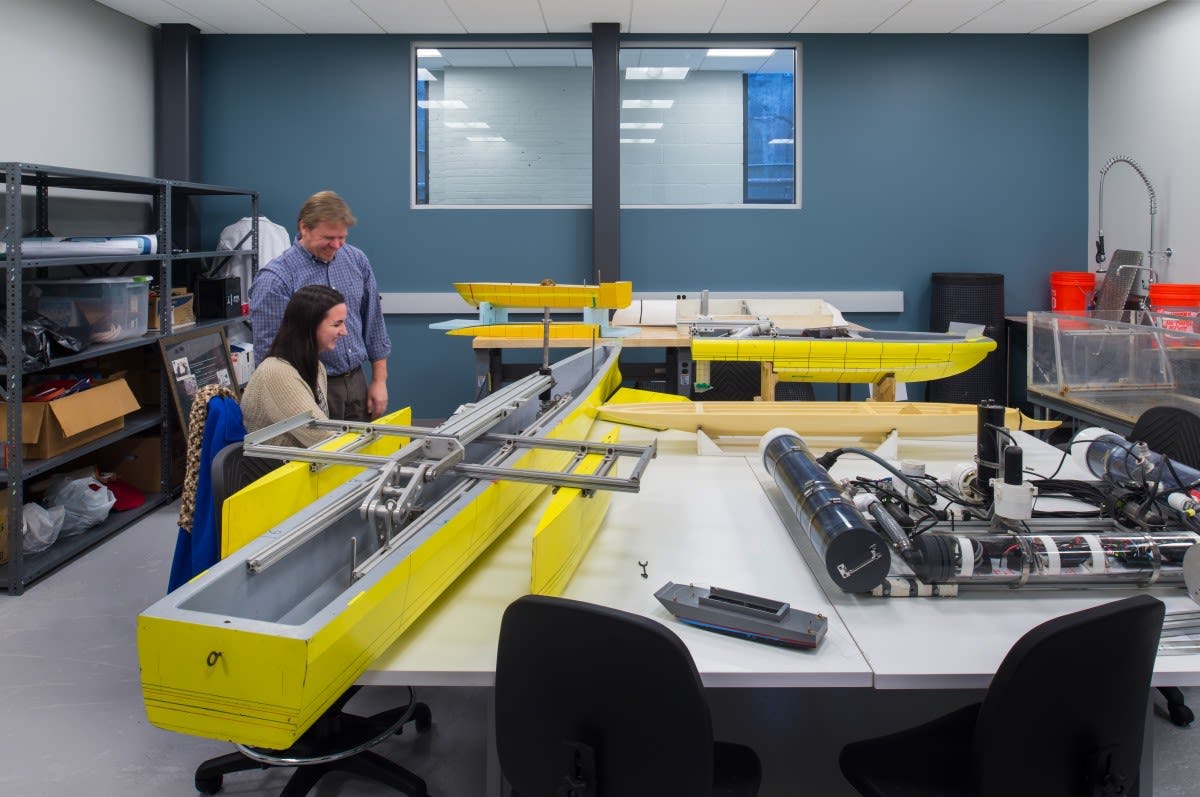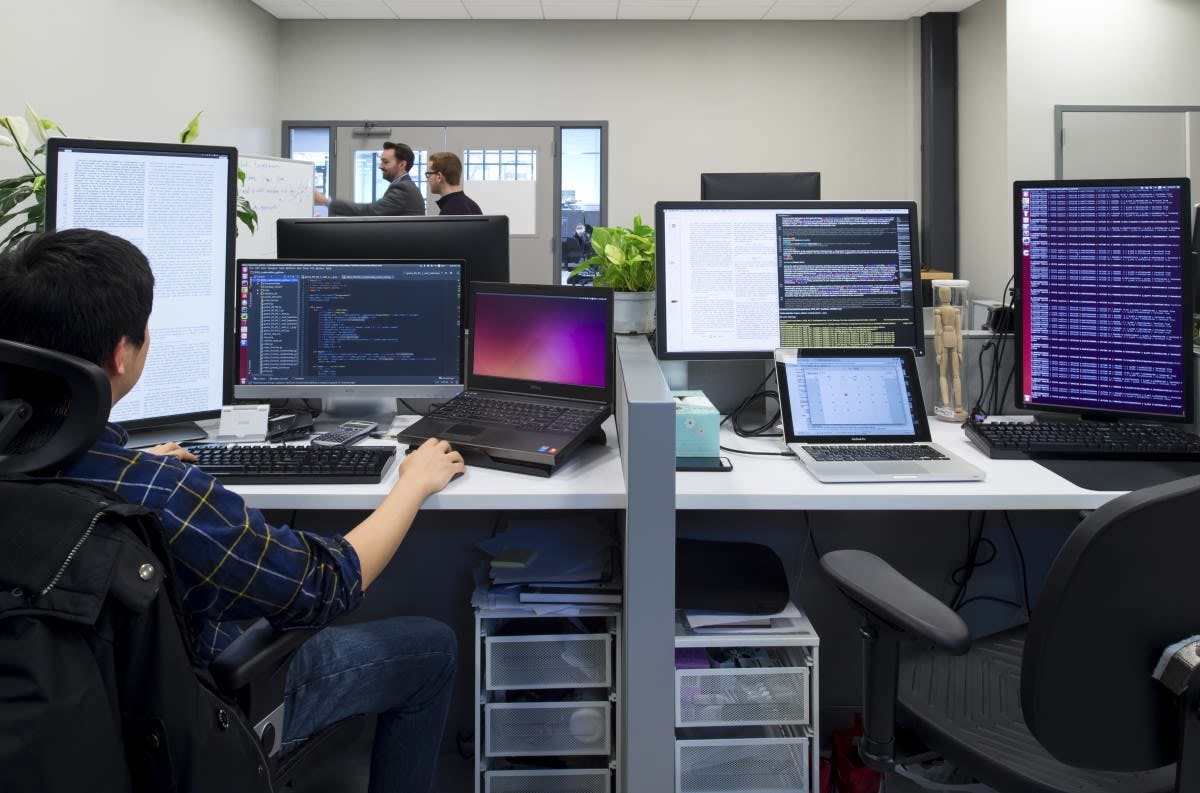The ABS Engineering Center's launch will expand Stevens' teaching and research capabilities to a world of new possibilities including robots, drones, safer buildings and bridges
Last November, Stevens Institute of Technology unveiled and dedicated the three-story ABS Engineering Center, enabled by the generous support of the Houston-based American Bureau of Shipping.
In a newly refurbished space, full-wall graphics nod to Stevens' heritage in naval engineering, maritime research and related areas — appropriate, since the structure was originally built during World War II with the support of the U.S. Navy, and was long used for testing torpedoes and other defense technologies and student projects.
Five laboratories now fill the multi-use space, extending Stevens' reach in key areas of engineering, design and homeland security.
"This is, first and foremost, a teaching facility," emphasizes School of Engineering & Science Interim Dean Keith Sheppard. "It will be a place for students to learn from faculty, and to learn together with each other as they work on design projects. And research, of course, will also take place here."
Five labs enabling teamwork, coursework, design work
Up and running since January, work in the Center ranges across disciplines, from robotics to building materials, maritime craft testing and green technology.
The Systems Integration Laboratory occupies most of the ground floor of the facility, creating a newly dedicated workspace for students to collaborate on required year-long senior design projects, chiefly in the mechanical, civil and naval engineering domains. Movable tables, white boards, projectors and storage cabinets set the stage for student teams as they work.
"This new ABS space adds assembly, electromechanical system-prototyping and demonstration space for courses in the Stevens design spine as well as those focused on innovation and entrepreneurship," notes IDEaS (Innovation, Design and Entrepreneurship at Stevens) program director Kishore Pochiraju, whose program manages the lab's central design space. "In concert with spaces in the Griffith and Carnegie buildings, more than 60 projects will be prototyping and testing in the Center space this spring, where students will have access to specialized prototyping cells including 3D printing."
Adjacent to the main space, a consolidated Fluids Laboratory unifies facilities and equipment previously spread across several buildings. Undergraduate civil, environmental and naval engineering students use the lab to take required core fluid dynamics courses, says Sheppard. Instructors utilize a hydraulic bench and small-scale wave tank, among other equipment, to study ship stability, wave mechanics, the effects of barriers on fluid flow and other relevant topics.
The Structural and Building Materials Laboratory, directed by Professor Marcus Rutner, provides facilities for the development and testing of innovative structural design, more resilient structures, new building materials and sensors to monitor structural health. The lab utilizes such equipment as static and dynamic testing frames, a furnace, environmental control chambers, evaluation software, infrared cameras and capabilities for composite manufacturing such as vacuum bagging.
Previous research supervised by Rutner has produced such innovations as WHISPER, a patent-pending wireless bridge-safety monitoring system developed by undergraduate students and faculty. Current research activities in the new space include the development of sensing technology to detect defects in materials at the micro-scale level, long before they become visible to the human eye. The sensing of micro-scale defects via scanning of the global structure is "a marriage of two extremes," notes Rutner, for which an optimal technology does not yet exist. A major research effort in the field conducted by the Stevens group is currently funded by the New Jersey Department of Transportation.
Another focus of the lab will be on the design and processing of composites with exceptional and tailored material properties at nano and microscale levels; current work includes developing a nanostructure-preserving metal-joining methodology. In addition, Rutner will continue to supervise research collaborations with partners including Princeton University and Texas A&M University.
"This new laboratory space and equipment provides Stevens faculty with unique possibilities for advancing education and research involving undergraduate and graduate students and to conducting interdisciplinary transformative research," Rutner says.
Explosives detection, Arctic research, underwater mapping
Also located in the ground-floor lab suite, the Naval Engineering Laboratory enables integration of the Davidson Laboratory’s knowledge base and laboratory infrastructure with naval and ocean engineering students. The new space serves as a home to student research and design projects related to the naval and marine fields, with a focus on multidisciplinary efforts.
"Student and faculty teams working in these areas have previously contracted with the Department of Defense to design underwater robots that search for submersed unexploded ordnance; research benign methods to stop potentially nefarious small craft; and develop a flotation device for U.S. Army Special Forces personnel," notes research associate professor Michael DeLorme, who assists lab director Raju Datla in management of the lab.
Ongoing projects here include research in marine energy efficiency, intermodal short sea shipping, the design of a green vessel for research operations in Arctic regions, and the design, development and deployment of a solar-electric boat.
Next door, in the newly relocated Robust Field Autonomy Laboratory, faculty and student researchers design and enhance mobile robots for the exploration and mapping of outdoor environments that are dangerous for humans to investigate, but critical to infrastructure maintenance.
A major focus, says lab director Brendan Englot, will be underwater robots working in close proximity to ships, piers and offshore platforms that intelligently determine where and how to map and inspect structures and crafts. The work could lead to robots that one day autonomously map the exterior of a ship, the underside of an oil drilling platform or the interior of a ship's bilge.
"The ABS Center will be a unique space for the cross-pollination of ideas from research and teaching activities in several different disciplines," adds Englot. "Cutting-edge, faculty-supervised research will be taking place right alongside the prototyping and testing of senior design projects. I'm excited to see the ideas and collaborations that will arise."
One of Englot's students, Kevin Doherty '17, develops algorithms to help Stevens' test robots create better three-dimensional maps on the fly as they scan the ground or seas.
"The ABS Center has allowed me to continue pursuing meaningful robotics research," notes Doherty, "because it facilitates interdisciplinary work motivated by the practical application of technology to real problems outside the academic research environment."
Space for seminars, faculty, drone testing
The upper floors of the facility will accommodate additional activities, including offices for teaching faculty drawn from various disciplines across campus — mechanical engineering professor Mishah Salman, systems engineering professor Eirik Hole, environmental engineering professor Elizabeth Fassman-Beck and civil engineering professor Leslie Brunell among them — and postdoctoral fellows. A seminar room with movable configurations can accommodate events, colloquia and presentations.
It's possible additional research and teaching will also be drawn in by the facility as time passes, adds Sheppard.
"There may be other areas that also benefit from this new Center," he says. "There has been discussion, for instance, of indoor drone testing in the space.
"It's clear this will truly be an interdisciplinary teaching and research facility, just as the ABS intended."





